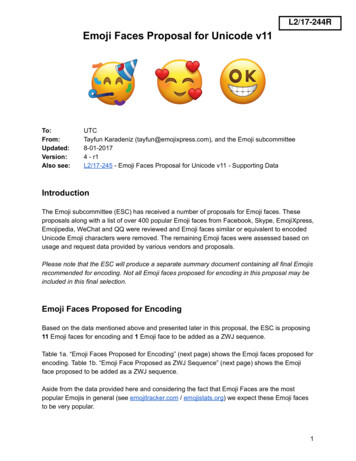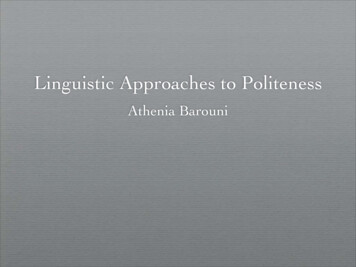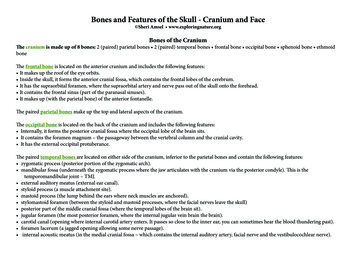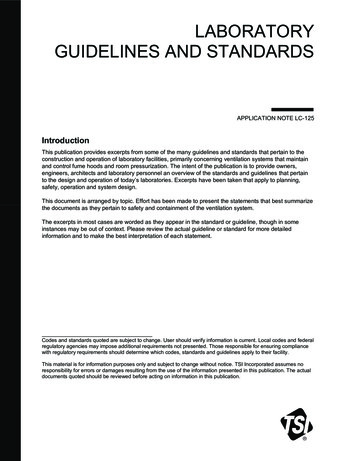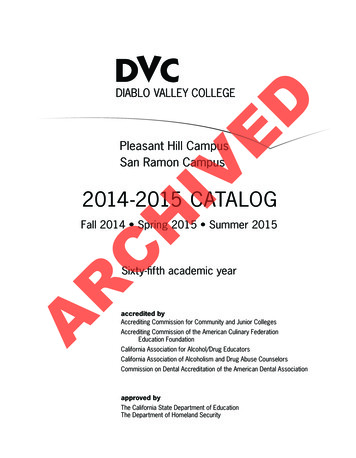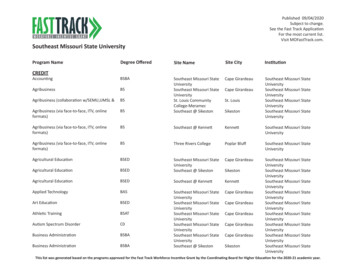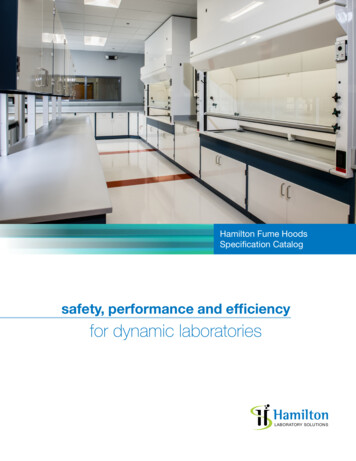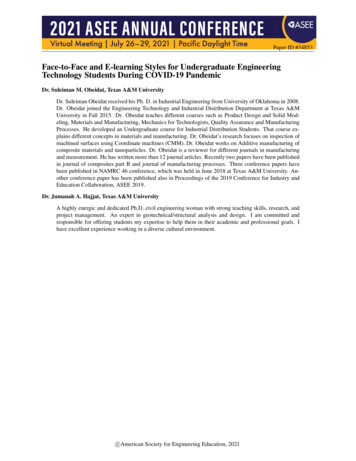
Transcription
Paper ID #34853Face-to-Face and E-learning Styles for Undergraduate EngineeringTechnology Students During COVID-19 PandemicDr. Suleiman M. Obeidat, Texas A&M UniversityDr. Suleiman Obeidat received his Ph. D. in Industrial Engineering from University of Oklahoma in 2008.Dr. Obeidat joined the Engineering Technology and Industrial Distribution Department at Texas A&MUniversity in Fall 2015. Dr. Obeidat teaches different courses such as Product Design and Solid Modeling, Materials and Manufacturing, Mechanics for Technologists, Quality Assurance and ManufacturingProcesses. He developed an Undergraduate course for Industrial Distribution Students. That course explains different concepts in materials and manufacturing. Dr. Obeidat’s research focuses on inspection ofmachined surfaces using Coordinate machines (CMM). Dr. Obeidat works on Additive manufacturing ofcomposite materials and nanoparticles. Dr. Obeidat is a reviewer for different journals in manufacturingand measurement. He has written more than 12 journal articles. Recently two papers have been publishedin journal of composites part B and journal of manufacturing processes. Three conference papers havebeen published in NAMRC 46 conference, which was held in June 2018 at Texas A&M University. Another conference paper has been published also in Proceedings of the 2019 Conference for Industry andEducation Collaboration, ASEE 2019.Dr. Jumanah A. Hajjat, Texas A&M UniversityA highly energic and dedicated Ph.D. civil engineering woman with strong teaching skills, research, andproject management. An expert in geotechnical/structural analysis and design. I am committed andresponsible for offering students my expertise to help them in their academic and professional goals. Ihave excellent experience working in a diverse cultural environment.c American Society for Engineering Education, 2021
Face-to-Face and E-Learning Styles for Undergraduate EngineeringTechnology Students During COVID-19 PandemicAbstract: Education has changed dramatically with the surging growth of online learning sincethe COVID-19 pandemic began, and the entire globe has turned away from the classrooms.Teaching has moved to be via digital platforms. With this abrupt shift to digital learning, a concernhas been raised about how this shift will affect worldwide learning. This research aims to studythe impact of the COVID-19 switch on student performance and whether online learning candeliver the same academic student performance as face-to-face. The data of this study wascompiled from three engineering courses taught at the engineering technology department at apublic university in Texas. The complexity of these courses ranges from low, average, and highlevels for courses A, B, and C, respectively. An analysis of variance (ANOVA) was used tocompare the differences in student performance outcomes of three exams and other gradedassignments. The impact of four learning modalities, involving face-to-face (F2F), synchronous,asynchronous, and mixed (F2F and synchronous), was explored. The results of the overall meanscores show that, for courses B and C, the student performance outcomes are higher in the mixed(F2F and synchronous) and online groups (synchronous and asynchronous groups) than in the F2Fgroup. For course A, there is a significant difference in the overall academic performance of onlinelearning modes compared to F2F. Whereby, in general, the F2F mode deliver a higher level ofstudent performance outcomes than that delivered by mixed and asynchronous groups for thesekinds of courses.Key words: Online teaching; Asynchronous teaching; Synchronous teaching; Studentperformance.1
IntroductionOnline learning has been excessively used in graduate education to accommodate student needsfor a more flexible learning environment and virtual connections (Bower et al. 2015). Onlinelearning enables college students to access their course works with limited financial resources andno relocation costs required (Dai 2019). However, this type of learning is no longer the exceptionfor graduate courses. Since the COVID-19 pandemic began and the whole world has shifted awayfrom being in person in classrooms, online education has been more demanded and worldwidegrowing at undergraduate college and K-12 levels. Whereby education can persist during thepandemic period. Online education creates digital spaces, not only between the students but alsobetween the students and their instructors. Online learning with no demand for the workplacesignificantly impacts the rate of enrollment and more rapidly during the COVID-19. However, theacademic success of the learners still the main concern.Several learning modalities have been developed and promising to persist in the future(Richardson et al. 2017; Seaman et al. 2018). Asynchronous online learning has become anadequate solution for some families who have children who cannot be in the classroom due toconflict in their work commitments (Gillies, 2008). Furthermore, it has helped students with healthproblems or others who cannot join the class at certain times due to bad weather (White et al.2010). With asynchronous learning, college students can complete their education at their ownpace from their remote sites. The students can participate in their online courses with no need tobe online with the instructor in real-time, from their convenient locations. Only students cancommunicate with their peers and instructors through discussion boards and emails. However, lackof social presence due to digital spaces in asynchronous education (Han 2013) and delayedfeedback and response (Karal et al. 2011) decrease student interaction. That decreases studentmotivation and engagement (Hastie et al. 2010; Karal et al. 2011).Synchronous online learning has received more attention than asynchronous onlinelearning and growing worldwide via several digital platforms during the COVID-19 pandemic.With advanced virtual learning tools offered by several video conferencing platforms, the studentscan interact virtually in the synchronous class with their instructor and peers (Watts 2016;Francescucci and Rohani 2019). Web conferencing tools of several platforms make synchronouslearning more functional and create a sense of student attendance in a real-time learningenvironment. Students can share their voices through audio tools, write their questions in chatwindows, and give prompt feedback through poll tools. Synchronous and asynchronous educationcan be successful through participating students in multiple activities to spend the required hoursdigesting the online materials (Nieuwoudt 2020). Synchronous mode offers more interactive andfunctional learning than asynchronous (Skylar 2009). Nevertheless, students still lack to interactphysically with their instructors and peers as the face-to-face class does. A blended synchronouslearning environment (BSLE) offers advantages of physical attendance and virtual learningthrough enabling students to join classroom activities simultaneously via their computers (Boweret al. 2015).This paper presents a study to evaluate student performance outcomes in three differentengineering technology courses taught to undergraduate students at a public university in Texas.2
The study aims to examine whether online learning modes can deliver the same studentperformance as face-to-face (F2F). The data involves the grades of three classes taught over threeconsecutive semesters by two instructors. One semester was before the COVID-19 pandemicperiod. The other two semesters were during the pandemic time when the whole world has movedfrom face-face learning to online learning via digital platforms. The study examined the impact offour different learning modalities; face-to-face, mixed (a mixture of face-to-face and synchronous),synchronous, and asynchronous. The collected data of outcomes of a total of 920 students wereanalyzed using the analysis of variance technique (ANOVA).MethodologyThis research compares the student performance outcomes of three different engineeringtechnology courses taught to undergraduate students at a public university in Texas. The studyinvolves four learning groups. The face-to-face (F2F) group was used as the control group, andthe other three groups were used as treatment groups involving synchronous, asynchronous, andmixed (F2F and synchronous) groups. That is to understand whether different learning modescontribute to the discrepancy in the student performance outcomes compared with those of F2F.The data of 920 students were compiled from the courses over three consecutive semesters fromtwo instructors. The courses were selected with different complexities, ranging from low, average,and high levels for courses A, B, and C, respectively. Instructor 1 taught course A, and courses Band C were taught by instructor 2.The content, of course A, covers concepts and manufacturing processes adopted inindustry. About 80% of the graded activities of this course contain conceptual questions and 20%of math workout problems. The other two classes (B and C) are mechanics courses. Course B isfor sophomore students, which requires new skills to learn the first engineering analysis conceptsat the department. Course C is for junior students. Students who enrolled in this course haveexcellent skills from previous courses. In fall 2019, all courses were taught in F2F mode. Allcourses were taught in the classrooms (F2F) in the first part of the spring 2020 semester. Then theyshifted away from the classrooms to synchronous mode during the COVID-19 pandemic till theend of that semester. In fall 2020, courses A and B were taught asynchronously, and course C wastaught synchronously.In asynchronous learning mode, all lectures of courses A and B were pre-recorded andposted in a time frame on the school blackboard learning system. That enabled students to watchthe videos and study the PowerPoint slides at their own pace from their remote sites. Insynchronous mode, the classes were taught by instructors in real-time via a digital platform. Theplatform assigned by the school was highly equipped with all interactive features required tocommunicate with the students such as video, audio, chat windows, polls, breakrooms, and others.Each course was taught by the same instructor over the three semesters, using the same materialcontents and assessments. Furthermore, all assessments were performed under a controlled andproctored environment in F2F and online modes. The graded assignments over the three semestersin the three courses remained with the same contents, formats, and complexity.3
Results and DiscussionIn this work, we do analysis to see whether the online learning mode can achieve the same levelof student performance outcomes as the F2F learning mode. That was measured using theoutcomes of three assessments (first, second, and final exams), homework assignments, freeresponse quizzes, clicker-quizzes (through the blackboard learning system), and lab (outcomes ofthe clicker quizzes and lab activities (only for course A)). The F2F course was used as a controlgroup to compare with the online treatment groups. For each graded individual, the student gradeswere normalized (out of 100%), then the mean scores were calculated accordingly. The datanormality and homogeneity of variances were checked and satisfied all conditions with a 95%confidence interval. ANOVA analysis was used in this paper to compare a pair of groups. Thecontrol (F2F) group was compared with one treatment group, considering one individual variable.Tables 1, 2, and 3 present the aggregated and individual student performance mean scores forcourses A, B, and C, respectively, for F2F and online learning groups. The aggregated mean scoresare presented in Figures 1, 2, and 3 for courses A, B, and C, respectively, for F2F and onlinelearning groups.For course A (Table 1), the individual outcomes reveal mixed results. For example, themean scores of the second exam, homework assignments, clicker and free-response quizzes, andlab show insignificant differences between the control F2F and the mixed groups. However, thereare significant differences in the first and final exams. Note that the instructors taught the materialsof the first exam in the classroom (F2F) before the COVID-19 pandemic start in spring 2020. Butthe overall outcomes show considerable differences between the F2F and the mixed groups (Table1 and Figure 1). In Fall 2020, the same instructor taught the same course (course A) but deliveredasynchronously. The aggregated outcomes show significant differences between those of the F2Fand the asynchronous groups. Based on the individual student performance outcomes, all meanscores show significant differences between the F2F and asynchronous groups, except that relatedto the homework assignments. It seems that an introductory course like course "A" deliveredasynchronously cannot be delivered at the same level as the F2F does in the classroom. However,both clicker and free-response quizzes in the asynchronous group appear to be better than those ofthe F2F group. That is due to the limited time assigned for students to finish their quizzes in theclassroom. But in the asynchronous class, 24 hours were assigned for students to submit theirquizzes with longer time than that in the F2F class. Even though the school offered hightechnology in the online classes, and all the materials were well-organized and prepared on theschool blackboard, it seems that the students needed to communicate with their instructor. Theengineering technology students are hands-on, and they prefer to do the experiments and feel thetested parts (i.e., machine parts) inside the lab to digest the class content. Thus, the exam gradesdecreased when shifted from F2F to online learning.4
Table 1. ANOVA analysis of student performance mean scores and p-values for course A taughtby instructor 1Fall 2019CourseA(Low)Spring 2020Fall 2020F2FMixed(Control Group) (Treatment Group)N 137First exam82Second exam81Final exam75HW83Clicker quiz60FR- quiz79Lab89Overall79N 1897880668063758976Async(Treatment Group)P valuea0.0040.3150.0000.0600.2320.2160.9450.004N 1717378688486898577P : mean scores out of 100; ANOVA: Analysis of Variance; F2F: Face to Face, Async: Asynchronous,Mixed: F2F and Synchronous; Valuea less than 0.05 indicates significant difference; Low complexity; FRquiz: Free-Response quiz.Figure 1: ANOVA results of overall mean scores for course A5
The overall student performance mean scores for course “B” (Table 2 and Figure 2) showstatistically significant differences between the F2F and the mixed groups. The mixed-mode candeliver better level of overall student performance outcomes than the F2F class does, as shown infigure 2. For the asynchronous group, the overall means show insignificant differences betweenthe F2F and asynchronous groups. However, the individual mean scores of all exams showstatistically significant differences, as p-values measured less than 0.05. The individual outcomesof homework assignments and quizzes are not affected if shifted from F2F to asynchronouslearning mode.For course “C” taught by the same instructor of course “B”, the aggregated studentperformance mean scores of both mixed and synchronous groups show significant differences, asp-values measured less than 0.05. The mean scores of the first and final exams show that both themixed and synchronous groups have higher levels of student performance outcomes than those ofthe F2F group. This is a remarkable finding consistent with some previous studies, in that the hightechnology offered in the online learning can deliver the same level of learning as the F2F class(Francescucci and Rohani 2019).Table 2. ANOVA analysis of student performance mean scores and p-values for course B taughtby instructor 2Fall 2019CourseB(Average)Spring 2020Fall 2020F2FMixed(control Group) (Treatment Group)N 97First exam58Second exam 90Final exam65HW75FR-quiz74Overall72N 72838663697676Async(Treatment Group)P valuea0.0000.1570.6090.1330.3220.009N 61748271817576P valuea0.0000.0280.0250.1150.6940.065Note: mean scores out of 100; ANOVA: Analysis of Variance; F2F: Face to Face, Async: Asynchronous,Mixed: F2F and Synchronous; Valuea less than 0.05 indicates significant difference; Average complexity;FR-quiz: Free-Response quiz.6
Figure 2: ANOVA results of the overall mean scores for course BTable 3. ANOVA analysis of student performance mean scores and p-values for course C taughtby instructor 2Fall 2019CourseC(High)Spring 2020Fall 2020F2FMixed(control Group) (Treatment Group)N 83First exam58Second exam 85Final exam58HW83FR-quiz92Overall72N 51788171838979Sync(Treatment Group)P valuea0.0000.2580.0000.9650.1700.000N 599747078799276P valuea0.0000.0000.0000.3400.8770.024Note: mean scores out of 100; ANOVA: Analysis of Variance; F2F: Face to Face, Sync: Synchronous,Mixed: F2F and Synchronous; Valuea less than 0.05 indicates significant difference; High complexity; FRquiz: Free-Response quiz.7
Figure 3. ANOVA results of the overall mean scores for course CConclusion:The impact of four learning modes is studied on the individual and the overall studentperformance mean scores for three different courses at different complexities. Analysis of variance(ANOVA) was used in this work as an analysis tool. By Looking at the overall performanceoutcomes of the students, it has been found that in course A, in which we mainly teach differentconcepts and manufacturing processes with almost 20% of workout problems, there is significanteffect of learning mode on the overall student performance where it is preferred to be taught F2F.In courses B and C, which are mechanics courses with 100% workout problems, the mixed andonline groups (synchronous and asynchronous) show higher student overall performance outcomesthan those in F2F groups. The study reveals that online learning can be as functional and effectiveas F2F, as long as the class material is well-organized and prepared in the digital platforms wherethe students can refer to the class material whenever needed.8
ReferencesBower, M., Dalgarno, B., Kennedy, G. E., Lee, M. J., & Kenney, J. (2015). Design andimplementation factors in blended synchronous learning environments: Outcomes from doi:10.1016/j.compedu.2015.03.0060360-1315Dai, Y. (2019). Situating videoconferencing in a connected class toward intercultural knowledgedevelopment: A comparative reflection approach. The Internet and Higher Education, 41,1-10. s, D. (2008). Student perspectives on videoconferencing in teacher education at a distance.Distance Education, 29(1), 107-118. doi:10.1080/01587910802004878Francescucci, A., and Rohani, L. (2019). Exclusively Synchronous Online (VIRI) Learning: TheImpact on Student Performance and Engagement Outcomes. Journal of MarketingEducation 41(1), 60–69. DOI: 10.1177/0273475318818864Han, H. (2013). Do nonverbal emotional cues matter? Effects of video casting in synchronousvirtual classrooms. American Journal of Distance Education, 27(4), 253-264.Hastie, M., Hung., I., Chen, N., Kinshuk. (2010). A blended synchronous learning model foreducational international collaboration. Innovations in Education and TeachingInternational, 47(1), 9-24.Karal, H., Çebi, A., & Turgut, Y. (2011). Perceptions of students who take synchronous coursesthrough video conferencing about distance education. The Turkish Online Journal ofEducational Technology, 10(4), 276-293.Nieuwoudt, J. E. (2020). Investigating synchronous and asynchronous class attendance aspredictors of academic success in online education. Australasian Journal of EducationalTechnology, 36(3), 15-25. https://doi.org/10.14742/ajet.5137Richardson, J. C., Maeda, Y., Lv, J., & Caskurlu, S. (2017). Social presence in relation to students’satisfaction and learning in the online environment: A meta-analysis. Computers in HumanBehavior, 71, 402-417.Seaman, J. E., Allen, I. E., & Seaman, J. (2018). Grade increase: Tracking distance education inthe United States. Babson Park, MA: Babson Survey Research Group.Skylar, A. A. (2009). A comparison of asynchronous online text-based lectures and synchronousinteractive web conferencing lectures. Issues in Teacher Education, 18(2), 69-84. Retrievedfrom ts, L. (2016). Synchronous and asynchronous communication in distance learning: A reviewof the literature. Quarterly Review of Distance Education, 17(1), 23-32.White, C., Ramirez, R., Smith, J., & Plonowski, L. (2010). Simultaneous delivery of a face-to-facecourse to on-campus and remote off-campus students. TechTrends, 54(4), 34-40.9
environment. Students can share their voices through audio tools, write their questions in chat windows, and give prompt feedback through poll tools. Synchronous and asynchronous education can be successful through participating students in multiple activities to spend the required hours digesting the online materials (Nieuwoudt 2020).
